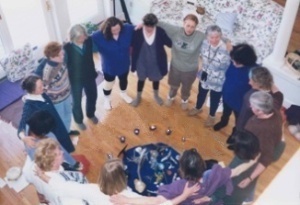The Circle Was at the Heart of the Women's Well
We saw the circle as a practice, a technique, a ritual, based on the principles of power-from-within and power-with, not power over others.

Figure 154-3, page 93, drawing by Linda Williams, fromThe Language of the Goddess, by Marija Gimbutas. Illustration of a bowl showing spinning tri-lines, spirals, and circles. Late Cucuteni, northeast Romania; 3800-3600 BC.
A circle creates sacred space; this is the basis of its power. As ritual, it acknowledges the availability of wisdom and help from something beyond our human dimension. It is a way of consciously asking grace to enter. For this to happen, sacred space needs to be clearly established in each circle. This can be done in many different ways – using ritual, creating altars, offering blessings or readings, guided or silent meditation, chanting and singing, sacred play, movement or dancing.
At the Women’s Well, we welcomed each woman’s unique way of acknowledging the sacredness of our endeavors.
We saw the circle as a safe and strong container for empowerment. Sitting in circle, each person is equidistant from the center; energy is distributed equally. Council format, an ancient tool used by native peoples and others, acknowledges this principle. In council, a talking object is passed, giving each woman a space in which to speak without interruption. Every voice is invited, given attention and respect.

Figure 167-1, page 102, drawing by James Bennett, fromThe Language of the Goddess, by Marija Gimbutas. Illustration of a Neolithic seal showing four spirals surrounding a seed, perhaps symbolizing growth and life. Central Anatolia; mid-7th millenium BC.
Council practice involves learning to be present to ourselves and others. We don’t plan what we are going to say, but try to let speech emerge from the truth of the moment. It also involves deep listening, cultivating an ability to truly hear, to acknowledge without judgment, and to resist offering quick fixes. Council process values silence and recognizes each person's right to pass without speaking.
We always held confidential what was said within the sacred circle. This commitment to confidentiality supported deep and honest sharing. As women and girls began to feel safe enough to speak honestly, they came to know and trust each other more deeply. As the truth of their lives was spoken, women learned that their narratives were valuable and they began to listen to and trust their own inner wisdom.
At the Women’s Well we always considered the circle a “held space.” Although each member contributed to the group's character, mood and direction, one or more women took the responsibility for establishing the parameters, monitoring the energy, inviting the deep speaking and deep listening, and encouraging trust, honesty, and authenticity to grow. We called these women the “holders of the circle.” These women were leaders, but not in the hierarchical sense. Power-with is a movement, a relationship, a fluid and changing balance, and responsive leadership wields power-with in ways that foster growth for all. The goal was to help each woman in the circle, including facilitators, to rest in her own balanced power.
In our work we were seeking to contribute to the healing and empowerment of women and the re-honoring of the feminine in a world severely out of balance. With few exceptions, only women attended our programs. It was never our intention to be separative or exclusive, yet we recognized that, for women to find their deepest selves and speak in their true voices, they needed to gather with other women in a place that felt safe, supportive, and non-judgmental. The Women's Well was such a place.
Circle Learnings
Without question, the most central thing we learned during all the years at the Women’s Well was to trust the power of the circle. In 1994, in the first year of the Women’s Spirituality Program, we were working out of an old model, though we didn’t realize it at first. After a powerful opening weekend, we met for a mid-week follow-up meeting and instructed the group to break into two small groups, on the assumption that there would be more trust and more sharing in these smaller configurations. The group protested. No, they would not leave each other. They would not be divided. Already, they had become a circle committed to each other, and to each other’s stories. They insisted on staying together. The facilitators listened and let go. As time unfolded that first year, the circle itself became more and more central to the life and learning of the Women’s Well.
Circle as Teacher
Another central learning was that of acknowledging the power of “the circle as teacher.” In the very first weekend of the Women’s Spirituality Program, we as facilitators arrived with our notes and preparations, but we soon learned that if we set a question for the group, or established a topic we wanted to focus on, and then helped circle members to center and become present to themselves and to their own life experience with this topic, we would all benefit. The learning then came from our own listening to ourselves and each other, rather than from teachers or facilitators as supposed experts. We came to call this process “the circle as teacher.” In a world which has not listened to the experience of its women, it was a profoundly healing and empowering way for us to learn.
Circle Ways
 There were several things that contributed to the power of the circle. We always began and ended with some centering process. It took different forms depending on who was the “holder of the circle.” For some it was drumming, for others a centering meditation, a song, a moment of silence, the sounding of a bell, the calling-in of the four directions. It was less important what it was, than that it happened and that it held the intention of going deeper. It gave circle members an opportunity to slow down, to let go of whatever distractions they were bringing from their day, and to come into the present moment and the sacred space of a “held circle.”
There were several things that contributed to the power of the circle. We always began and ended with some centering process. It took different forms depending on who was the “holder of the circle.” For some it was drumming, for others a centering meditation, a song, a moment of silence, the sounding of a bell, the calling-in of the four directions. It was less important what it was, than that it happened and that it held the intention of going deeper. It gave circle members an opportunity to slow down, to let go of whatever distractions they were bringing from their day, and to come into the present moment and the sacred space of a “held circle.”
We also closed each circle in some ritual way. We didn’t just drift casually away from each other, but took the time to pause, to express gratitude, to sing, to silently acknowledge what we shared. Sometimes it was as simple as joining hands and looking around the circle at each of the other women. There were many ways of closing the circle, but it always happened. We never said, “We are short of time, let’s skip this part.” It was essential to the ritual form that we both opened and closed the circle consciously.
Gift Circles
One strand of the tapestry that comprised the Women's Well was that we offered women's circles for which no payment was required. Three intertwined concepts inspired the offering of these “gift circles.”
The first came from one member’s vision of a sacred place or temple for women that was always open and welcoming, a constant and accessible resource and refuge. Although the Women’s Well couldn’t manage to be open and available at all times, we decided that at least we could offer some circles where no payment or preregistration was required. Thus, women could come to these circles without planning ahead, knowing the circle was there waiting for them. Sometimes someone would come in and, heaving a big sigh, say with a sense of relief as she settled into the circle, “I have been trying to get here for months – I'm so glad to be here!”
The second was the concept of a gifting culture, as described by Lewis Hyde and also by Genevieve Vaughan, in which exchanges in a community are not based on trading one carefully calibrated measure of value for another. Rather, in these societies precious things are offered as gifts, with no expectation of an immediate and compensatory return. In the words of Lewis Hyde, “The gift must always move.” We wanted to include this different kind of cultural approach in our work.
The third inspiration was a consciousness of privilege and a wish to make the blessing of the Women’s Well available to women with limited financial resources.
An early manifestation of this impulse came in 1999, when we started holding a monthly gathering called the Circle of Circles. In the Circle of Circles, we shared stories, made connections with the seasonal cycles of the Earth, and allowed our true voices to come forth. These circles were always offered as a gift, with no payment or preregistration required. Those able to “pass the gift along” could, if they wished, make a donation to the Women’s Well. Attendance at these circles could be unpredictable, which initially felt unsettling for the women holding the circles, but over the years the facilitators came to see it as a profound opportunity to trust, and to welcome with an open heart whoever might appear on any given evening.
Beginning in the fall of 2000, we began offering a variety of other gift circles, where some teachers and facilitators donated their time and women could attend without payment. Both the original Circle of Circles and the other gift courses arose from the inspiration of Jane LeCompte. It was she who introduced us to this transformative concept. It resonated with the spirit of the Women's Well and reflected our efforts to explore alternatives to the dominant culture which was so driven by materialism and monetary exchanges.
In addition, the Women’s Well was dedicated to paying our teachers generously. We had only one very part-time paid administrative staff person. The majority of the work was done by volunteers who gave their time and talents. We said on many occasions, the Women's Well exists because of the generosity of many women. And it was indeed true.
The content on this web site is a co-creation of a number of women, to whom we are extremely grateful. The image on our banner (top of page) depicts the interior of a Karanovo dish from Bulgaria, c. 4500 BC. Source: Figure 338, page 218, The Language of the Goddess, by Marija Gimbutas. Joan Marler, ed. New York: Harper & Row, 1989; used with permission.
Hover on black-and-white drawings on this page to see source information.
If you wish to contact us, we have a gmail address. Our screen name is womenswellinfo.
Web hosting is provided by freehostia.com.

Figure 154-3, page 93, drawing by Linda Williams, fromThe Language of the Goddess, by Marija Gimbutas. Illustration of a bowl showing spinning tri-lines, spirals, and circles. Late Cucuteni, northeast Romania; 3800-3600 BC.

Figure 167-1, page 102, drawing by James Bennett, fromThe Language of the Goddess, by Marija Gimbutas. Illustration of a Neolithic seal showing four spirals surrounding a seed, perhaps symbolizing growth and life. Central Anatolia; mid-7th millenium BC.
Hover on black-and-white drawings on this page to see source information.
If you wish to contact us, we have a gmail address. Our screen name is womenswellinfo.
Web hosting is provided by freehostia.com.
